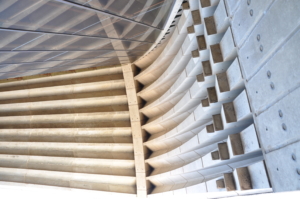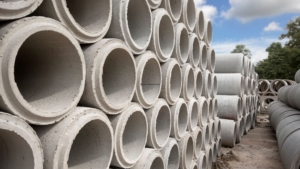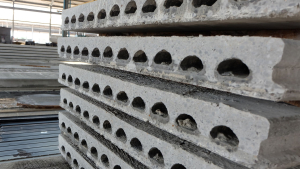Precast concrete is a very versatile material. There are numerous construction projects that can benefit from the many advantages of precast concrete. It’s a building material that’s durable, strong, easy, and cost-effective to install.
What is Precast Concrete?
It is a commonly used construction material that is made by pouring concrete into a mold and allowing it to cure. Precast concrete can then be taken to a job site and used for many construction applications.
Where is Precast Used?
The number of ways in which precast concrete can be used might surprise you. The precast concrete industry produces products that can be used both inside and outside as well. Let’s look at some of the ways you might choose to use it.
Use of Precast Concrete in Frames
You can use precast concrete in two types of precast building frames.
Structural Frame
This type of frame comprises precast concrete columns paired with beams, and slabs. It is typically used for retail developments, car parks, and office buildings.
The Cross-Wall Frame
This type of frame is made up of solid walls and floor slabs. You’ll generally find it used for hospitals, schools, and hotels.
Use of Precast Concrete for Floors
This is a very popular way of using precast concrete. More than five million square meters of precast floor slabs are used in the construction industry annually. Just to put it into perspective, that’s equivalent to more than 700 football pitches which makes it a popular material for the modern construction site.
The main types of precast floor slabs include:
- Plank
- Hollow core
- Beam and a block
- Double tee
Use of Precast Concrete in Cladding
Another common application for precast concrete is in the form of cladding. It can be a structural element in a building, but it is more often used as a non-structural decorative facade.
The concrete backing will contain ordinary precast concrete elements. However, the facade will be a special mix. For example, manufacturers might be producing precast concrete using white Portland cement. It’s possible to create various forms, colors, and details.
In Which Type of Projects Can You Use Precast Concrete?
You can use precast concrete for many different types of projects. Here is a list of the most common ones.
- Parking Structures: There are many different ways precast concrete is used in parking structures. For example, traffic barriers, stairs, columns, architectural veneer, paving slabs, and many more. It is used for single-level, mid-rise, and large-level parking structures.
- Foundations: Many buildings, such as residential homes, use precast concrete foundations. You’ll also see it used for walls and floors. Precast concrete materials are a popular choice because they provide an energy-efficient and moisture-free basement.
- Compound Wall: Compound walls are built to separate two adjacent plots of land. Precast compound walls are popular because they are very durable, quick to erect, economical, and can be purchased in various designs. They are also very aesthetically pleasing and provide excellent privacy.
- Bridges: Various sections of this type of precast concrete construction can be made using precast concrete. For example, caps, deck slabs, girders, arches, beams, and much more. The size of the bridge makes no difference, and the engineers constructing the bridge can make it blend with the surrounding environment, whether it’s natural or historical.
- Culverts: Culverts help with wastewater and stormwater drainage, and precast concrete is the perfect material to use because it’s a top-quality product that’s durable and can be efficiently installed.
- Curb Inlets, Catch Basins, and Manhole Covers: These many precast concrete structures play a crucial role in wastewater management. Various standards relate to these structures, and precast concrete production meets all requirements.
- Sound Walls: These precast concrete walls are used by many businesses because they are an excellent solution for blocking unwanted noise. You might also see them used alongside busy highways. The precast concrete walls reflect sound, mostly back in the general direction of the source.
- Retaining Walls: Precast concrete is used in many types of retaining walls, both commercial and residential, mechanically stabilized earth panels, segmental retaining wall, sea walls, and similar large precast modular blocks.
- Agricultural Products: Precast concrete can withstand extreme weather conditions and last for many decades, even with constant use. These features make it ideal for a variety of agricultural applications. Examples include slurry channels, concrete panels, livestock feed and watering troughs, J- and H-bunks, cattle grids, agricultural fencing, cattle feed bunks, and bunker silos.
- Building Components and Site Amenities: Precast concrete tends to be used for cladding, fireplace mantels, curtain walls, accessories, and trim products. There are also structural applications such as beams, foundations, walls, floors, and similar components.
- Sanitary and Stormwater: Precast concrete used for this type of application will be specifically engineered so that it treats and removes pollutants from sanitary and stormwater run-off. The products include catch basins, manholes, and stormwater detention vaults.
- Utility Structures: Precast concrete is also used for protecting vital utility connections and utility distribution controls. This material is used because it is environmentally safe and non-toxic. Examples of precast concrete products include meter boxes, light pole bases, hand holds, pull boxes, panel vaults, hollow-core products, telecommunications structures, transformer vaults and pads, utility vaults and buildings, and many other utility structures.
- Water and Wastewater Products: Precast concrete can also be used to contain or hold water, oil, or other liquids, which makes it a very good material to be used in the wastewater and water industries. Products include septic tanks, wet wells, fire cisterns, leaching puts, grease interceptors, and dry wells.
- Transportation and Traffic-Related Products: Precast concrete is a popular material for use in airport, railroad, and road transportation systems. It can be used for bridge systems, railroad ties and crossings, Jersey barriers, concrete barriers, tunnel segments, central reservation barriers, bollards, underpasses, and pedestrian subways.
- Modular Paving: It’s possible to cast concrete in many different colors and textures, which makes it perfect for modular paving. It can even be made to mimic wood, stone, or brick.
- Cemetery Products: Precast concrete can create a watertight structure, so it is often used for constructing mausoleums or underground vaults. The material can also withstand natural forces for long periods.
- Hazardous Materials Containment: Hazardous materials need to be contained in storage locations that are strong and able to withstand terrorist attacks or natural disasters. Precast concrete fits the bill.
- Marine Products: You’ll find precast concrete is also in use for the construction of floating docks, decking, seawalls, underwater infrastructure, and many other amenities you might find along the waterfront. Precast concrete is heavy but counteracts the buoyant forces of water better than many other materials.
What Are the Most Common Precast Products?
Two of the most common applications for precast concrete manufacturing products are retaining walls and hardscaping. Precast concrete is used because it can be formed into stackable, interlocking blocks. These blocks are extremely stable and provide excellent structure for walls, stairways, and other applications.
Other common uses of precast concrete include:
- Foundations
- Pocket footings
- Combined footings
- Precast piles
- RCC beams
- Prestressed concrete beams
- Shell beams
- Various types of slabs
- Load-bearing and non-load-bearing walls
- Precast roof joists
Famous Precast Concrete Buildings
Precast concrete products enjoyed a boom time during the 1930s, which meant that many iconic buildings were built at that time. Some of the more stunning examples include:
- Sydney Opera House: Precast concrete architectural panels were used to create the distinctive peaked and curved roof. They were then covered in glossy matte-cream and white tiles. In total, 2,194 precast concrete sections were used in the building’s construction.
- Pan American Building: The building that houses the PanAm headquarters was completed in 1963. It stands 800 feet tall and was inspired by Bauhaus design.
- Diego Portales University: This building has a natural feel about it that is partly due to the exposed concrete slab walls. They complement the building’s natural surroundings. The balconies and windows may seem randomly placed at first glance, but they are carefully positioned to optimize cross ventilation.
- Walters Art Museum of Baltimore: This building opened its doors in 1934 and has been exciting art enthusiasts ever since. Admission is free. The highlighted concrete slabs were built to mimic large canvasses.
- Jubilee Church: Architectural precast panels were used to construct this eye-catching church. They serve two purposes. Firstly, they attract the eye, but in addition, they clean the air. The precast concrete fins contain titanium dioxide, which absorbs UV light that then breaks down any pollutants that come into contact with the surface of the church. This is the reason for the church’s continual white color.
- The Pierre: This private residence was built using precast concrete and sat on top of a natural stone deposit. The stone that was cut away to make room for the construction of this home was crushed and used for making the cement.
Conclusion
Precast concrete is a material that’s timeless. The uses of precast concrete are also almost endless. It can be made in so many shapes, sizes, and colors, that there are few construction applications and precast concrete structures it can’t be used for.





